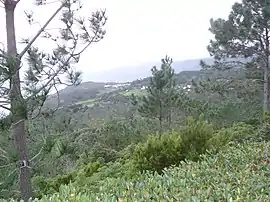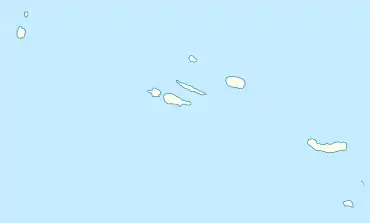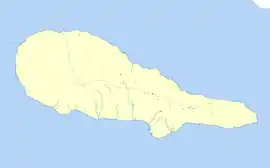Prainha (São Roque do Pico)
Prainha is a civil parish in the municipality of São Roque do Pico on the island of Pico, in the Portuguese archipelago of the Azores. The population in 2011 was 547,[1] in an area of 26.10 km².[2]
Prainha | |
|---|---|
 The village of Prainha de Cima, as seen from the Recreational Forest Reserve of Prainha, along the north coast of Pico | |
 Prainha Location in the Azores  Prainha Prainha (Pico) | |
| Coordinates: 38°28′56″N 28°14′8″W | |
| Country | |
| Auton. region | Azores |
| Island | Pico |
| Municipality | São Roque do Pico |
| Area | |
| • Total | 26.10 km2 (10.08 sq mi) |
| Elevation | 216 m (709 ft) |
| Population (2011) | |
| • Total | 547 |
| • Density | 21/km2 (54/sq mi) |
| Time zone | UTC−01:00 (AZOT) |
| • Summer (DST) | UTC±00:00 (AZOST) |
| Postal code | 9940-040 |
| Area code | 292 |
| Patron | Nossa Senhora das Candeias |
Geography
Prainha is located on the northern coast of the municipality of São Roque do Pico, buttressed by parishes of Riberinha in the east, and the village of São Miguel Arcanjo (in the neighboring parish of São Roque) to the west. Generally, the parish is located on a high coastal plateau and slopes progressively towards to the Achada Plain in the interior. The Estrada Regional E.R.1-1ª runs along the coastal plateau and links to its neighbors, while lateral roads cross it perpendicularly to connect to the semi-isolated settlements. To about mid-altitudes and around the regional road most of the parcels of land are used for cattle-raising and cultivation, above these areas the more mountainous landscape is covered in dense vegetation and scrub forests. The parish is also affected by denser vegetation in the eastern frontier with Ribeirinha, and a swath of forest and endemic plants in the western coast. This latter area, extends from the coast to the interior, and pertains to the Recreational Forest Reserve of Prainha. The region actually includes debris and lava from a geological eruption that produced a massive fajã along the northern coast (equally divided between Prainha and São Roque).
In addition to Prainha (most commonly referred to as Prainha de Baixo), the civil parish includes the hamlets of Prainha de Cima and Canto da Areia. These are scattered centers primarily, with most homes and businesses scattered along the regional road. Prainha de Baixo is primarily considered a summer resort area, with one (volcanic) sandy beach, natural pools and cottages, although it is inhabited with annual residents. Prainha de cima and Canto da Areia are both inhabited by permanent residents, as well.

.jpg.webp)
.jpg.webp)
.jpg.webp)
